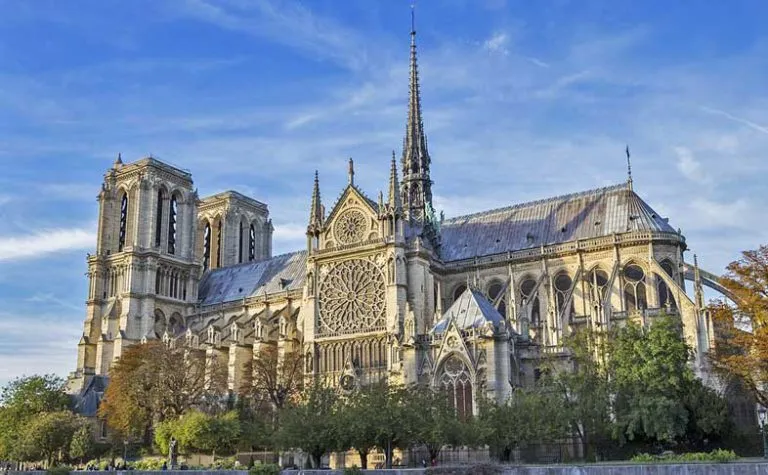
Introduction
Notre-Dame de Paris (“Our Lady of Paris”), referred to simply as Notre-Dame, is a medieval Catholic cathedral on the Île de la Cité (an island in the Seine River), in the 4th arrondissement of Paris, France. The cathedral, dedicated to the Virgin Mary, is considered one of the finest examples of French Gothic architecture. Several of its attributes set it apart from the earlier Romanesque style, particularly its pioneering use of the rib vault and flying buttress, its enormous and colourful rose windows, and the naturalism and abundance of its sculptural decoration. Notre Dame also stands out for its musical components, notably its three pipe organs and its immense church bells.
Construction of the cathedral began in 1163 under Bishop Maurice de Sully and was largely completed by 1260, though it was modified frequently in the centuries that followed. In the 1790s, during the French Revolution, Notre-Dame suffered extensive desecration; much of its religious imagery was damaged or destroyed. In the 19th century, the coronation of Napoleon I and the funerals of many of the French Republic’s presidents took place at the cathedral.
The 1831 publication of Victor Hugo’s novel Notre-Dame de Paris (known in English as The Hunchback of Notre-Dame) inspired popular interest in the cathedral, which led to a major restoration project between 1844 and 1864, supervised by Eugène Viollet-le-Duc. On August 26, 1944, the Liberation of Paris from German occupation was celebrated in Notre-Dame with the singing of the Magnificat. Beginning in 1963, the cathedral’s façade was cleaned of centuries of soot and grime. Another cleaning and restoration project was carried out between 1991 and 2000.
The cathedral is one of the most widely recognized symbols of the city of Paris and the French nation. In 1805, it was awarded the honorary status of a minor basilica. As the cathedral of the archdiocese of Paris, Notre-Dame contains the cathedra of the archbishop of Paris (Laurent Ulrich).
In the early 21st century, approximately 12 million people visited Notre-Dame annually, making it the most visited monument in Paris. The cathedral has long been renowned for its Lent sermons, a tradition founded in the 1830s by the Dominican Jean-Baptiste Henri Lacordaire. In recent years, these sermons have increasingly often been given by leading public figures or government-employed academics.
Over time, the cathedral has gradually been stripped of many of its original decorations and artworks. However, the cathedral still contains several noteworthy examples of Gothic, Baroque, and 19th-century sculptures, a number of 17th- and early 18th-century altarpieces, and some of the most important relics in Christendom – including the Crown of Thorns, a sliver of the true cross and a nail from the true cross.
On 15 April 2019, while Notre-Dame was undergoing renovation and restoration, its roof caught fire and burned for about 15 hours. The cathedral sustained serious damage as a result. The flèche (the timber spirelet over the crossing) was destroyed, as was most of the lead-covered wooden roof above the stone vaulted ceiling. This resulted in contamination of the site and the nearby environment with lead.
After the fire, many of the proposals for restoration suggested modernizing the cathedral’s design, but the French National Assembly rejected this approach, enacting a law on 29 July 2019 that required the restoration to preserve the cathedral’s “historic, artistic and architectural interest”. The task of stabilizing the building against possible collapse was completed in November 2020, and reconstruction began in 2021.
The government of France has said it hopes the reconstruction can be completed by Spring 2024, in time for the opening of the 2024 Summer Olympics in Paris. President Emmanuel Macron confirmed on 14 April 2021 that the cathedral site will be formally returned to the church on 15 April 2024, and that the first mass since the fire will be held in the cathedral nave on that day, even if the reconstruction has not been finished by then.
History of Cathédrale Notre-Dame de Paris, France

It is believed that before the arrival of Christianity in France, a Gallo-Roman temple dedicated to Jupiter stood on the site of Notre-Dame. Evidence for this includes the Pillar of the Boatmen, discovered beneath the cathedral in 1710. In the 4th or 5th century, a large early Christian church, the Cathedral of Saint Étienne, was built on the site, close to the royal palace.
The entrance was situated about 40 metres (130 ft) west of the present west front of Notre-Dame, and the apse was located about where the west façade is today. It was roughly half the size of the later Notre-Dame, 70 metres (230 ft) long and separated into nave and four aisles by marble columns, then decorated with mosaics.
The last church before the cathedral of Notre-Dame was a Romanesque remodeling of Saint-Étienne that, although enlarged and remodeled, was found to be unfit for the growing population of Paris. A baptistery, the Church of Saint-John-le-Rond, built about 452, was located on the north side of the west front of Notre-Dame until the work of Jacques-Germain Soufflot in the 18th century.
In 1160, the Bishop of Paris, Maurice de Sully, decided to build a new and much larger church. He summarily demolished the earlier cathedral and chose to recycle its materials. Sully decided that the new church should be built in the Gothic style, which had been inaugurated at the royal abbey of Saint Denis in the late 1130s.
Architecture
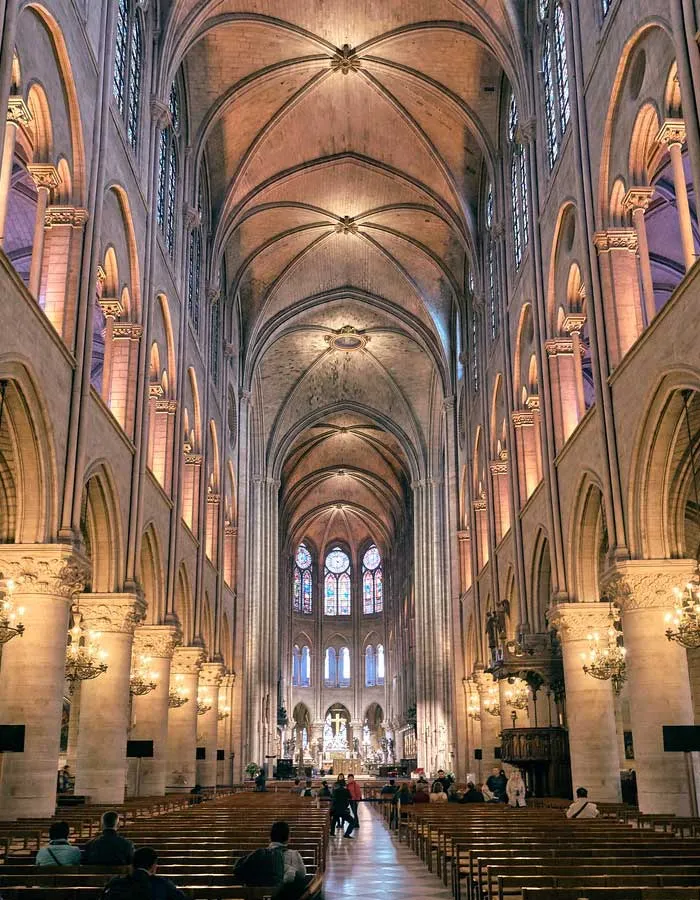
The chronicler Jean de Saint-Victor [fr] recorded in the Memorial Historiarum that the construction of Notre-Dame began between 24 March and 25 April 1163 with the laying of the cornerstone in the presence of King Louis VII and Pope Alexander III. Four phases of construction took place under bishops Maurice de Sully and Eudes de Sully, according to masters whose names have been lost. Analysis of vault stones that fell in the 2019 fire shows that they were quarried in Vexin, a county northwest of Paris, and presumably brought up the Seine by ferry.
The first phase began with the construction of the choir and its two ambulatories. According to Robert of Torigni, the choir was completed in 1177 and the high altar consecrated on 19 May 1182 by Cardinal Henri de Château-Marçay, the Papal legate in Paris, and Maurice de Sully.
The second phase, from 1182 to 1190, concerned the construction of the four sections of the nave behind the choir and its aisles to the height of the clerestories. It began after the completion of the choir but ended before the final allotted section of the nave was finished. Beginning in 1190, the bases of the façade were put in place, and the first traverses were completed. Heraclius of Caesarea called for the Third Crusade in 1185 from the still-incomplete cathedral.
Louis IX deposited the relics of the passion of Christ, which included the Crown of thorns, a nail from the Cross and a sliver of the Cross, which he had purchased at great expense from the Latin Emperor Baldwin II, in the cathedral during the construction of the Sainte-Chapelle. An under-shirt, believed to have belonged to Louis, was added to the collection of relics at some time after his death.
The decision was made to add transepts at the choir, where the altar was located, in order to bring more light into the centre of the church. The use of simpler four-part rather than six-part rib vaults meant that the roofs were stronger and could be higher. After Bishop Maurice de Sully’s death in 1196, his successor, Eudes de Sully oversaw the completion of the transepts, and continued work on the nave, which was nearing completion at the time of his own death in 1208.
By this time, the western façade was already largely built, though it was not completed until around the mid-1240s. Between 1225 and 1250 the upper gallery of the nave was constructed, along with the two towers on the west façade.
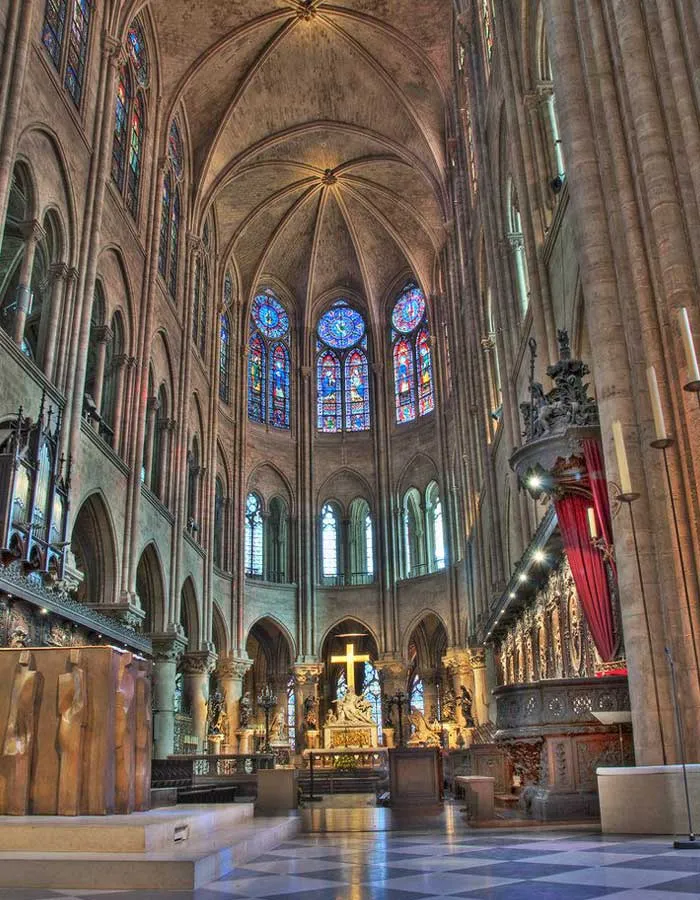
French Revolution and Napoleon
After the French Revolution in 1789, Notre-Dame and the rest of the church’s property in France was seized and made public property. The cathedral was rededicated in 1793 to the Cult of Reason, and then to the Cult of the Supreme Being in 1794. During this time, many of the treasures of the cathedral were either destroyed or plundered. The twenty-eight statues of biblical kings located at the west façade, mistaken for statues of French kings, were beheaded.
Many of the heads were found during a 1977 excavation nearby, and are on display at the Musée de Cluny. For a time the Goddess of Liberty replaced the Virgin Mary on several altars. The cathedral’s great bells escaped being melted down. All of the other large statues on the façade, with the exception of the statue of the Virgin Mary on the portal of the cloister, were destroyed. The cathedral came to be used as a warehouse for the storage of food and other non-religious purposes.
With the Concordat of 1801, Napoleon Bonaparte restored Notre-Dame to the Catholic Church, though this was only finalized on 18 April 1802. Napoleon also named Paris’s new bishop, Jean-Baptiste de Belloy, who restored the cathedral’s interior. Charles Percier and Pierre-François-Léonard Fontaine made quasi-Gothic modifications to Notre-Dame for the coronation of Napoleon as Emperor of the French within the cathedral. The building’s exterior was whitewashed and the interior decorated in Neoclassical, then in vogue.
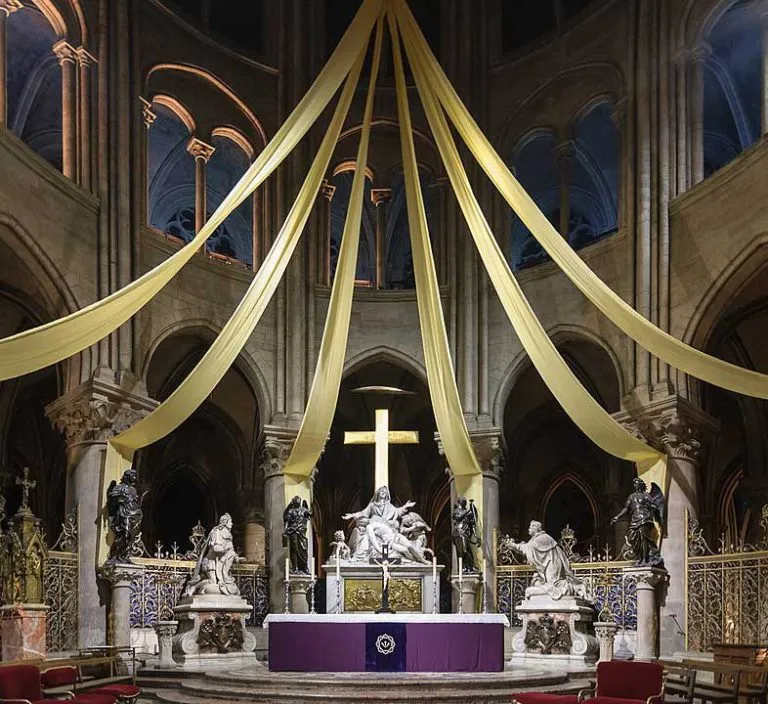
Restoration
In the decades after the Napoleonic Wars, Notre-Dame fell into such a state of disrepair that Paris officials considered its demolition. Victor Hugo, who admired the cathedral, wrote the novel Notre-Dame de Paris (published in English as The Hunchback of Notre-Dame) in 1831 to save Notre-Dame. The book was an enormous success, raising awareness of the cathedral’s decaying state. The same year as Hugo’s novel was published, however, anti-Legitimists plundered Notre-Dame’s sacristy. In 1844 King Louis Philippe ordered that the church be restored.
The architect who had hitherto been in charge of Notre-Dame’s maintenance, Étienne-Hippolyte Godde, was dismissed. In his stead, Jean-Baptiste Lassus and Eugène Viollet-le-Duc, who had distinguished themselves with the restoration of the nearby Sainte-Chapelle, were appointed in 1844. The next year, Viollet-le-Duc submitted a budget of 3,888,500 francs, which was reduced to 2,650,000 francs, for the restoration of Notre-Dame and the construction of a new sacristy building.
This budget was exhausted in 1850, and work stopped as Viollet-le-Duc made proposals for more money. In totality, the restoration cost over 12 million francs. Supervising a large team of sculptors, glass makers and other craftsmen, and working from drawings or engravings, Viollet-le-Duc remade or added decorations if he felt they were in the spirit of the original style. One of the latter items was a taller and more ornate spire, to replace the original 13th century spire, which had been removed in 1786. The decoration of the restoration included a statue of Saint Thomas that resembles Viollet-le-Duc, as well as the sculpture of mythical creatures on the Galerie des Chimères.
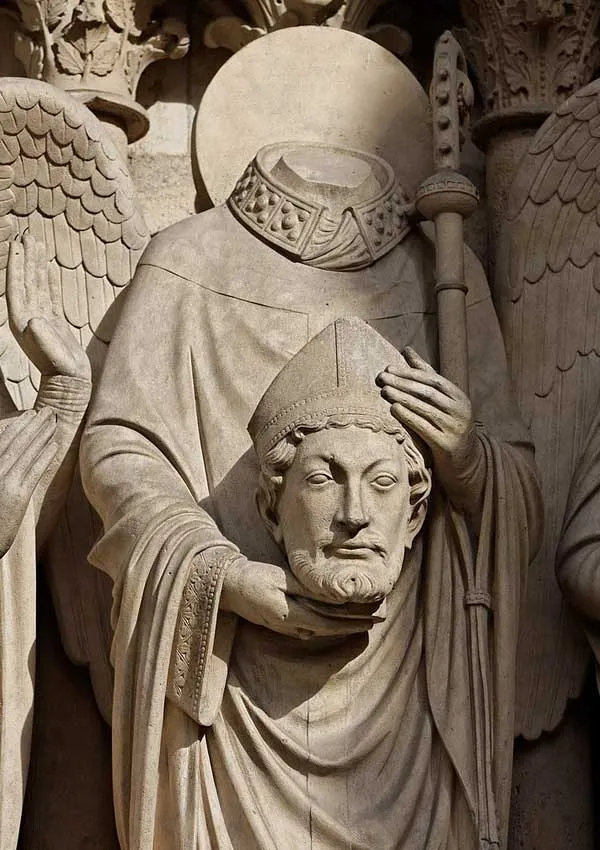
The construction of the sacristy was especially financially costly. To secure a firm foundation, it was necessary for Viollet-le-Duc’s labourers to dig 9 metres (30 ft). Master glassworkers meticulously copied styles of the 13th century, as written about by art historians Antoine Lusson and Adolphe Napoléon Didron.
In 1963, on the initiative of culture minister André Malraux and to mark the 800th anniversary of the cathedral, the façade was cleaned of the centuries of soot and grime, restoring it to its original off-white colour.
On 19 January 1969, vandals placed a North Vietnamese flag atop a spire of the Notre Dame, and sabotaged the stairway leading to it. The flag was cut from the spire by Paris Fire Brigade Sergeant Raymond Belle in a daring helicopter mission, the first of its kind in France.
The Requiem Mass of Charles de Gaulle was held in Notre-Dame on 12 November 1970. The next year, on 26 June 1971, Philippe Petit walked across a tight-rope strung up between Notre-Dame’s two bell towers and entertained spectators.
After the Magnificat of 30 May 1980, Pope John Paul II celebrated Mass on the parvis of the cathedral.
The Requiem Mass of François Mitterrand was held at the cathedral, as with past French heads of state, on 11 January 1996.
The stone masonry of the cathedral’s exterior had deteriorated in the 19th and 20th century due to increased air pollution in Paris, which accelerated erosion of decorations and discoloured the stone. By the late 1980s, several gargoyles and turrets had also fallen off or become too loose to remain in place.
A decade-long renovation programme began in 1991 and replaced much of the exterior, with care given to retain the authentic architectural elements of the cathedral, including rigorous inspection of new limestone blocks. A discreet system of electrical wires, not visible from below, was also installed on the roof to deter pigeons. The cathedral’s pipe organ was upgraded with a computerized system to control the mechanical connections to the pipes. The west face was cleaned and restored in time for millennium celebrations in December 1999.
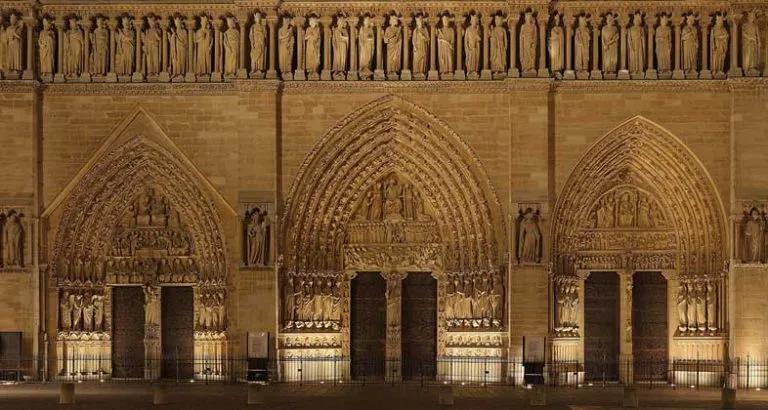
21st Century
The Requiem Mass of Cardinal Jean-Marie Lustiger, former archbishop of Paris and Jewish convert to Catholicism, was held in Notre-Dame on 10 August 2007.
The set of four 19th-century bells atop the northern towers at Notre-Dame were melted down and recast into new bronze bells in 2013, to celebrate the building’s 850th anniversary. They were designed to recreate the sound of the cathedral’s original bells from the 17th century.
Despite the 1990s renovation, the cathedral had continued to show signs of deterioration that prompted the national government to propose a new renovation program in the late 2010s. The entire renovation was estimated to cost €100 million, which the archbishop of Paris planned to raise through funds from the national government and private donations. A €6 million renovation of the cathedral’s spire began in late 2018 and continued into the following year, requiring the temporary removal of copper statues on the roof and other decorative elements days before the April 2019 fire.
Notre-Dame began a year-long celebration of the 850th anniversary of the laying of the first building block for the cathedral on 12 December 2012. During that anniversary year, on 21 May 2013, Dominique Venner, a historian and white nationalist, placed a letter on the church altar and shot himself, dying instantly. Around 1,500 visitors were evacuated from the cathedral. French police arrested two people on 8 September 2016 after a car containing seven gas canisters was found near Notre-Dame.
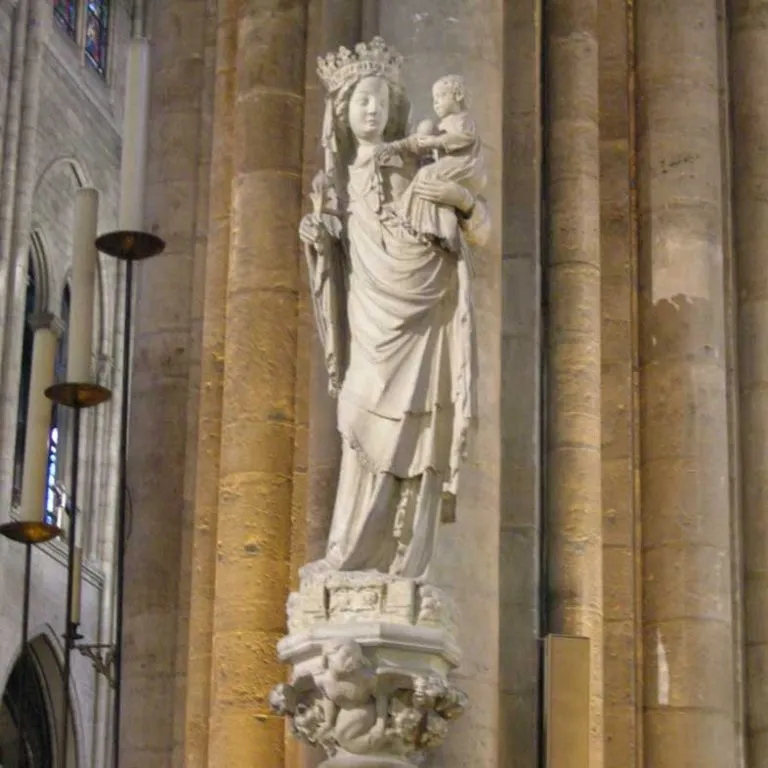
Colour and Controversy
The bright colour of the restored interior will come as a shock to many visitors, accustomed to the grimy gray of the pre-fire cathedral. “The whiteness under the dirt was quite spectacular”, according to General Jean-Louis Georgelin, the French army officer heading the restoration.
The stone was sprayed with a latex solution to lift the centuries of grime and soot. However, the cleaning of the church interior with latex solutions was criticized by Michael Daley of Artwatch UK, referring to the earlier cleaning of Saint Paul’s Cathedral in London. He asked, “Is there any good basis for wishing to present an artificially brightened and ahistorical white interior?”
Jean-Michel Guilemont of the French Ministry of culture responded, “The interior elevations will regain their original colour, since the chapels and side aisles were very dirty. Of course it is not a white colour. The stone has a blonde colour, and the architects are very attentive to obtaining a patina which respects the centuries”.
Towers and the Spire
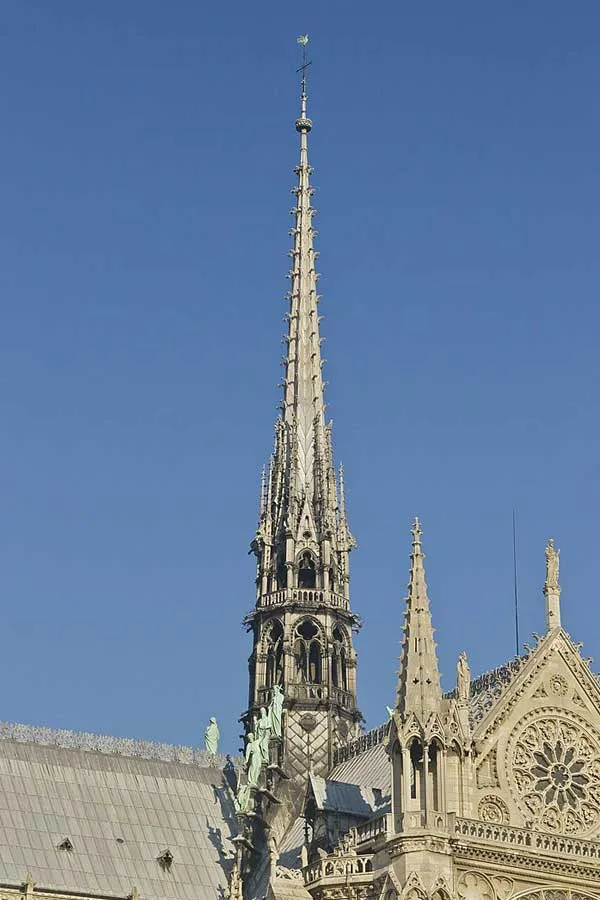
The two towers are 69 metres (226 ft) high, and were the tallest structures in Paris until the completion of the Eiffel Tower in 1889. The towers were the last major element of the cathedral to be constructed. The south tower was built first, between 1220 and 1240, and the north tower between 1235 and 1250. The newer north tower is slightly larger, as can be seen when they are viewed from directly in front of the church. The contrefort or buttress of the north tower is also larger.
The south tower was accessible to visitors by a stairway, whose entrance was on the south side of the tower. The stairway has 387 steps, and has a stop at the Gothic hall at the level of the rose window, where visitors could look over the parvis and see a collection of paintings and sculpture from earlier periods of the cathedral’s history.
The fourteen bells of the cathedral are located in the north and south towers.
The cathedral’s flèche (or spire) was located over the transept. The original spire was constructed in the 13th century, probably between 1220 and 1230. It was battered, weakened and bent by the wind over five centuries, and finally was removed in 1786. During the 19th-century restoration, Eugène Viollet-le-Duc decided to recreate it, making a new version of oak covered with lead. The entire spire weighed 750 tonnes.
Viollet-le-Duc’s plans, the spire was surrounded by copper statues of the twelve Apostles a group of three at each point of the compass. In front of each group is a symbol representing one of the four evangelists: a winged ox for Saint Luke, a lion for Saint Mark, an eagle for Saint John and an angel for Saint Matthew. Just days prior to the fire, the statues were removed for restoration. While in place, they had faced outwards towards Paris, except one: the statue of Saint Thomas, the patron saint of architects, faced the spire, and had the features of Viollet-le-Duc.
The rooster weathervane atop the spire contained three relics: a tiny piece from the Crown of Thorns in the cathedral treasury, and relics of Saint Denis and Saint Genevieve, patron saints of Paris. They were placed there in 1935 by Archbishop Jean Verdier, to protect the congregation from lightning or other harm. The rooster with relics intact was recovered in the rubble shortly after the fire.
Stained Glass – Rose Windows
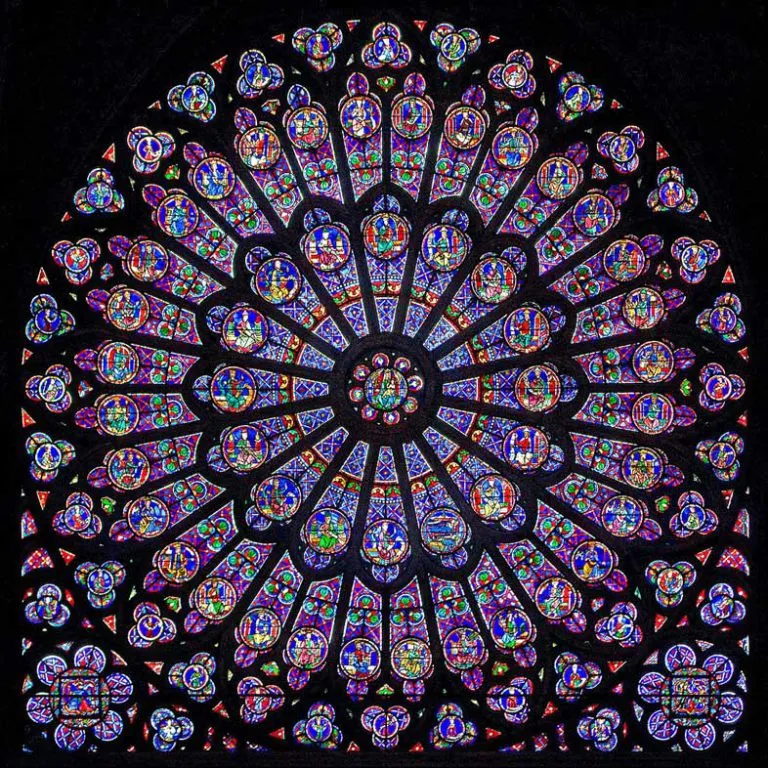
The stained glass windows of Notre-Dame, particularly the three rose windows, are among the most famous features of the cathedral. The west rose window, over the portals, was the first and smallest of the roses in Notre-Dame. It is 9.6 metres (32′) in diameter, and was made in about 1225, with the pieces of glass set in a thick circular stone frame. None of the original glass remains in this window; it was recreated in the 19th century.
The two transept windows are larger and contain a greater proportion of glass than the rose on the west façade, because the new system of buttresses made the nave walls thinner and stronger. The north rose was created in about 1250, and the south rose in about 1260. The south rose in the transept is particularly notable for its size and artistry. It is 12.9 metres (42′) in diameter; with the claire-voie surrounding it, a total of 19 metres (62′). It was given to the cathedral by King Louis IX of France, known as Saint Louis.
The south rose has 94 medallions, arranged in four circles, depicting scenes from the life of Christ and those who witnessed his time on earth. The inner circle has twelve medallions showing the twelve apostles. The next two circles depict celebrated martyrs and virgins. The fourth circle shows twenty angels, as well as saints important to Paris, notably Saint Denis, Margaret the Virgin with a dragon, and Saint Eustace. The third and fourth circles also have some depictions of Old Testament subjects. The third circle has some medallions with scenes from the New Testament Gospel of Matthew which date from the last quarter of the 12th century. These are the oldest glass in the window.
Burials and Crypts
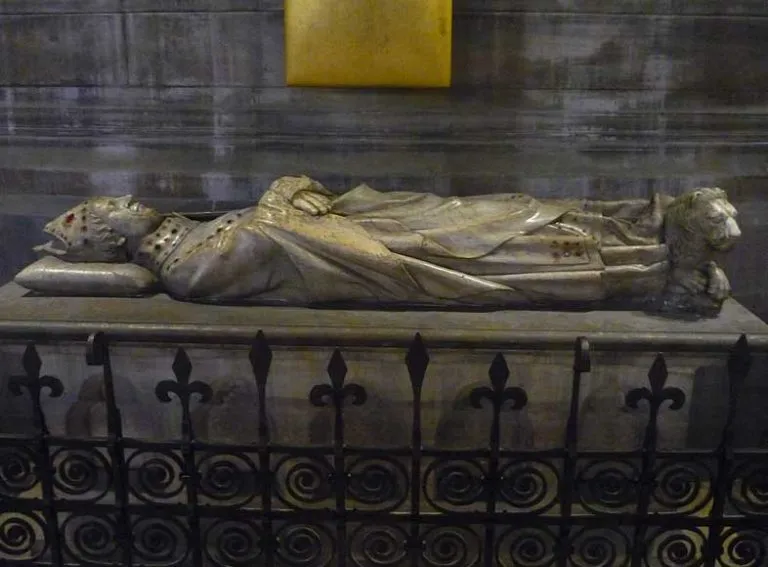
Unlike some other French cathedrals, Notre-Dame was originally constructed without a crypt. In the medieval period, burials were made directly into the floor of the church, or in above-ground sarcophagi, some with tomb effigies. High-ranking clergy and some royals were buried in the choir and apse, while many others, including lower-ranking clergy and lay people, were buried in the nave or chapels. There is no surviving complete record of all of the burials made at this time.
In 1699, many of the choir tombs were disturbed or covered over during a major renovation project. Remains which were exhumed were reburied in a common tomb beside the high altar. In 1711, a small crypt measuring about six meters by six meters (20′ x 20′) was dug out in the middle of the choir which was used as a burial vault for the archbishops, if they had not requested to be buried elsewhere. It was during this excavation that the 1st century Pillar of the Boatmen was discovered.
In 1758, three more crypts were dug in the Chapel of Saint-Georges to be used for burials of canons of Notre-Dame. In 1765, a larger crypt was built under the nave to be used for burials of canons, beneficiaries, chaplains, cantors, and choirboys. Between 1771 and 1773, the cathedral floor was repaved with black and white marble tiles, which covered over most of the remaining tombs. This prevented many of these tombs from being disturbed during the Revolution.
In 1858, the choir crypt was expanded to stretch most of the length of the choir. During this project, many medieval tombs were rediscovered. Likewise the nave crypt was also rediscovered in 1863 when a larger vault was dug out to install a vault heater. Many other tombs are also located in the chapels.
Great Organ
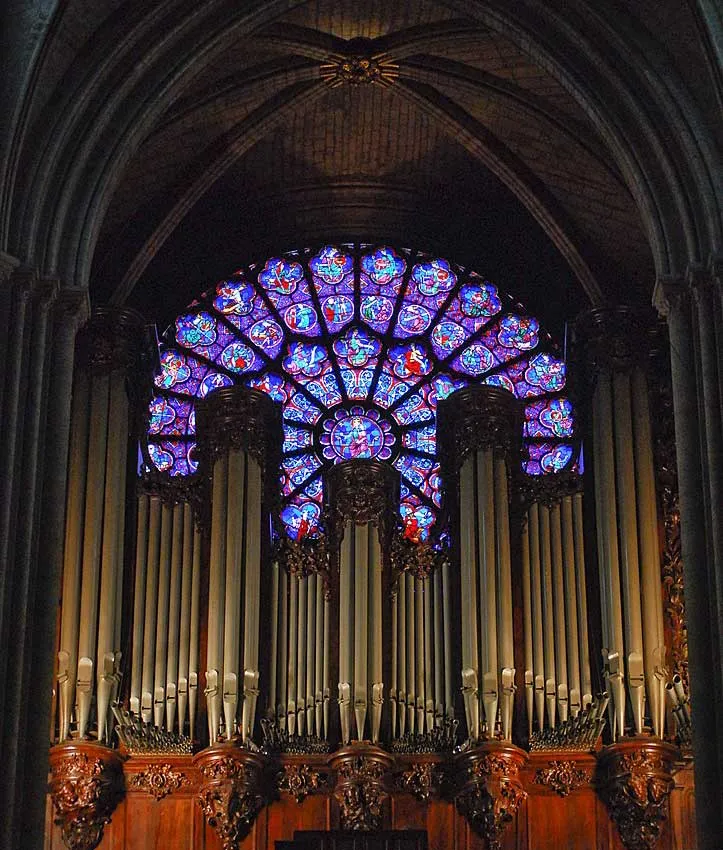
One of the earliest organs at Notre-Dame, built in 1403 by Frédéric Schambantz, was rebuilt many times over the course of 300 years, however 12 pipes and some wood survive from this ancient instrument. It was replaced between 1730 and 1738 by François Thierry, and later rebuilt by François-Henri Clicquot. During the restoration of the cathedral by Eugène Viollet-le-Duc, Aristide Cavaillé-Coll built a new organ, using pipework from the former instruments. The organ was dedicated in 1868.
In 1904, Charles Mutin modified and added several stops upon the suggestions of titular organist Louis Vierne; in 1924, an electric blower was installed, which was financed by Rolls-Royce CEO, Claude Johnson. An extensive restoration and cleaning was carried out by Joseph Beuchet in 1932 which mostly included changes to the Récit. Between 1959 and 1963, the mechanical action with Barker levers was replaced with an electric action by Jean Hermann, and a new organ console was installed.
Bells
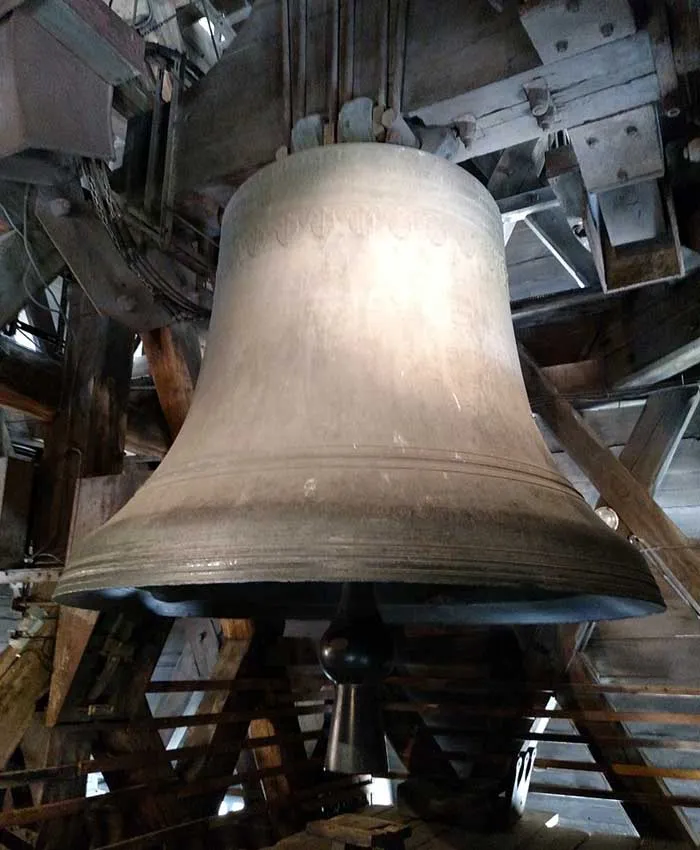
Notre-Dame currently has ten bells. The two largest bells, Emmanuel and Marie, are mounted in the south tower. The eight others; Gabriel, Anne Geneviève, Denis, Marcel, Étienne, Benoît-Joseph, Maurice, and Jean-Marie; are mounted in the north tower. In addition to accompanying regular activities at the cathedral, the bells have also rung to commemorate events of national and international significance, such as the armistice of 11 November 1918, the liberation of Paris, the fall of the Berlin Wall, and the September 11 attacks.
The bells are made with bronze for its resonance and resistance to corrosion. During the medieval period, they were often founded on the grounds of the cathedral so they would not need to be transported long distances. According to tradition, the bishop of Paris held a ceremony in which he blessed and baptized the bells, and a godparent formally bestowed a name on the bell. Most of the cathedral’s early bells were named after the person who donated them, but they were also named after biblical figures, saints, bishops, and others.
Clock
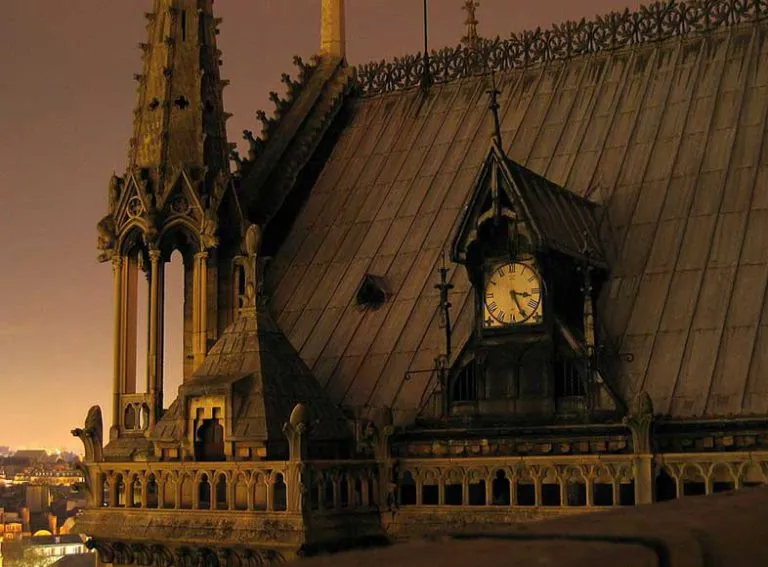
The first clocks used at Notre-Dame were clepsydras. These were used to tell the hours, which were marked by striking bells. In the 14th century Notre-Dame had two clepsydras running simultaneously, one in the cloister and one in the church itself. A lay chamberlain was responsible to keep the clocks filled with water and to notify a churchwarden when it was time to strike the bells for the hour.
In 1766, Guillot de Montjoye and Jean-Bernard de Vienne, canons and stewards of the church fabric, donated a mechanical clock to the cathedral. The movement was installed in a glass cabinet in the gallery beneath the north rose window and rang three bells placed outside above the north portal. Between 1812 and 1813, the clock and bells were moved to the north tower. A 1.34 metres (4 ft 5 in) clock face was installed inside the church below the organ platform.
During Viollet-le-Duc’s restoration in the 19th century, a new clock was made. The 1867 Collin-Wagner movement, measuring two metres (6.5 feet) across, was located in the forest underneath the central spire within a glass-enclosed room. This controlled four dormer clock faces visible on the transept roofs, two on each side.
This clock was destroyed by the fire. Shortly after the fire, French clockmaker Jean-Baptiste Vior discovered an almost identical 1867 Collin-Wagner movement in storage at Sainte-Trinité Church in northern Paris. Olivier Chandez, who had been responsible for the upkeep of Notre-Dame’s clock, described the find as “almost a miracle.” While the clock cannot simply be installed in Notre-Dame itself, it is hoped that the clock can be used to create a new clock for Notre-Dame to the same specifications as the one which was destroyed.
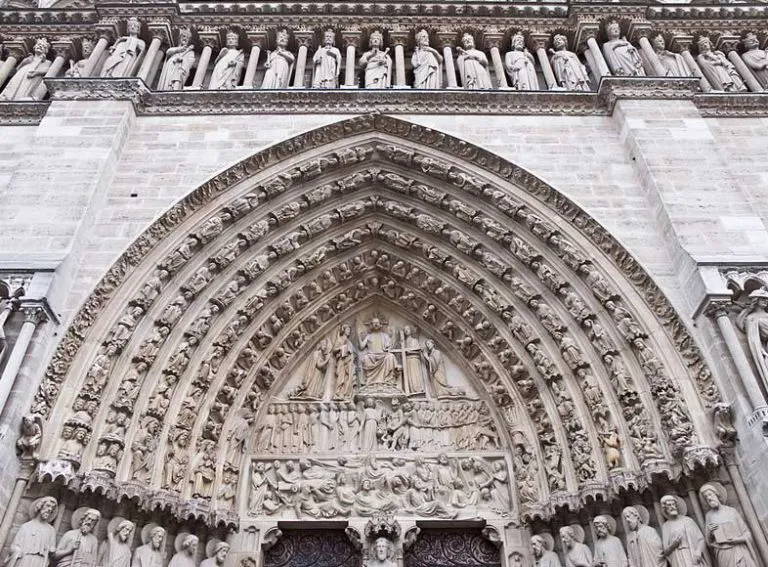
Ownership
Until the French Revolution, Notre-Dame was the property of the archbishop of Paris and therefore the Roman Catholic Church. It was nationalized on 2 November 1789 and since then has been the property of the French state. Under the Concordat of 1801, use of the cathedral was returned to the Church, but not ownership. Legislation from 1833 and 1838 clarified that cathedrals were maintained at the expense of the French government.
This was reaffirmed in the 1905 law on the separation of Church and State, designating the Catholic Church as having the exclusive right to use it for religious purposes in perpetuity. Notre-Dame is one of seventy historic churches in France with this status. The archdiocese is responsible for paying the employees, for security, heating and cleaning, and for ensuring that the cathedral is open free to visitors. The archdiocese does not receive subsidies from the French state.

Feast Day - 26th November
Annual Feast Day of Notre-Dame Cathedral held on 26th November.
Mass Time
Weekdays
Saturdays
Sundays
Church Visiting Time
Contact Info
6 Parvis Notre-Dame – Place Jean-Paul II,
75004, Paris, France
Phone No.
Tel : +33 1 42 34 56 10
Accommodations
How to reach the Cathedral
Paris Orly Airport commonly referred to as Orly, is one of two international airports serving the French capital, Paris, the other one being Charles de Gaulle Airport (CDG). It is located partially in Orly and partially in Villeneuve-le-Roi, 13 km south of Paris, France is the nearby Airport to the Cathedral.
Saint-Michel Notre-Dame Transit Station in Paris, France is the nearby Train Station to the Cathedral.








